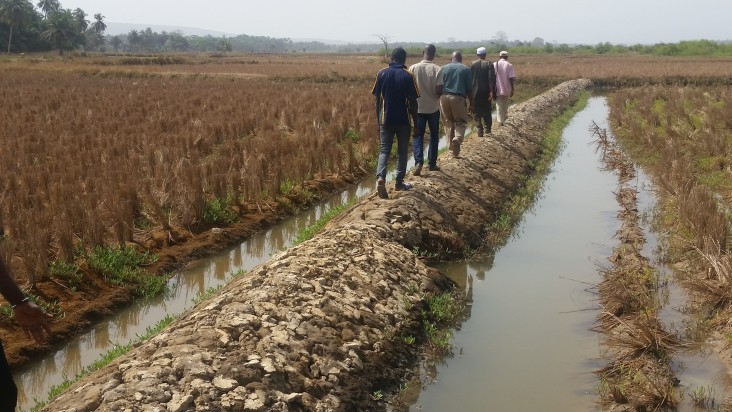Speeches Shim

May 2018 — Tabantougny is a seaside community in Guinea’s prefecture of Boffa, with a main activity of rice cultivation in mangrove areas. Since 2013, the community has been faced with a chronic food shortage due to seawater destroying the farmland. Irrigation and flood protection infrastructure is old and often dilapidated, causing sea water to enter the farmlands and destroy the crops.
The situation was aggravated by the Ebola outbreak in 2014, when almost everyone fled the community, which is located 150 kilometers north of Conakry.
In 2017, USAID’s Improved Livelihood and Agricultural Development Project started providing technical and financial support to farmers who owned more than 2 hectares of farmland with the objective of rehabilitating dikes and mitigating economic loss in the event of flooding caused by dike failure.
The project provided five producers in Tabantougny with financial assistance to purchase farm implements and hire farmhands to restore damaged dikes to a quality higher than their original state. The farmers also constructed evacuation channels to avoid stagnant sea water in the farmland. This investment has resulted in sustained rice production.
“Before the project’s intervention, I got less than 500 kilos of rice on 5 hectares. In the worst cases, I do not get a single grain. Now, with the dike protection system, I get 1.5 to 3 tons of rice per harvest,” says Fode Ali Soumah, 65, head of the Union of Producer Groups of Kolisokho, and one of the beneficiaries of the dike rehabilitation project.
The direct socioeconomic benefits of this dike rehabilitation project include increased food security and the creation of a model for dike systems in other seaside communities in Boffa.
“We are appealing to the project managers to extend its activities to other communities in Boffa because, here in Tabantouny, it has helped us a lot. We no longer take seeds on credit with high interest rate, we no longer have to take debts to ensure our children go to school, and the youth who had left the community because of hunger have returned,” added Soumah.
The project is also expected to be sustainable as the dike is too important to the community for the owners to allow it to deteriorate and lose its integrity. However, further support is needed to extend the project’s support to smallholder farmers.
“We had abandoned our farms to resort to other petty activities like fishing, selling palm oil, salt, fonio and peanut to sustain our families because the rice harvest was always a disaster. Now we know what to do to avoid this in the future,” said Soumah.
Amadou Bangoura, the only beneficiary of the project in Sibali, another community in Boffa, says he is planning to invest one-third of each of his future harvests to improve the new flood protection system, claiming that it has helped increase his rice production from 1 to 3 tons.
The Improved Livelihood and Agricultural Development Project — which is part of the U.S. Government's global hunger and food security initiative, Feed the Future — helps improve economic opportunities in selected Ebola-affected communities in Guinea’s mining areas. Since it began in March 2017, the project has reached more than 450 beneficiaries in Boffa, 262 of whom are women, with training in basic agriculture skills, entrepreneurship, food marketing, and the introduction of improved technologies and improved seed varieties. The project ends in December 2019.
LINKS

Comment
Make a general inquiry or suggest an improvement.